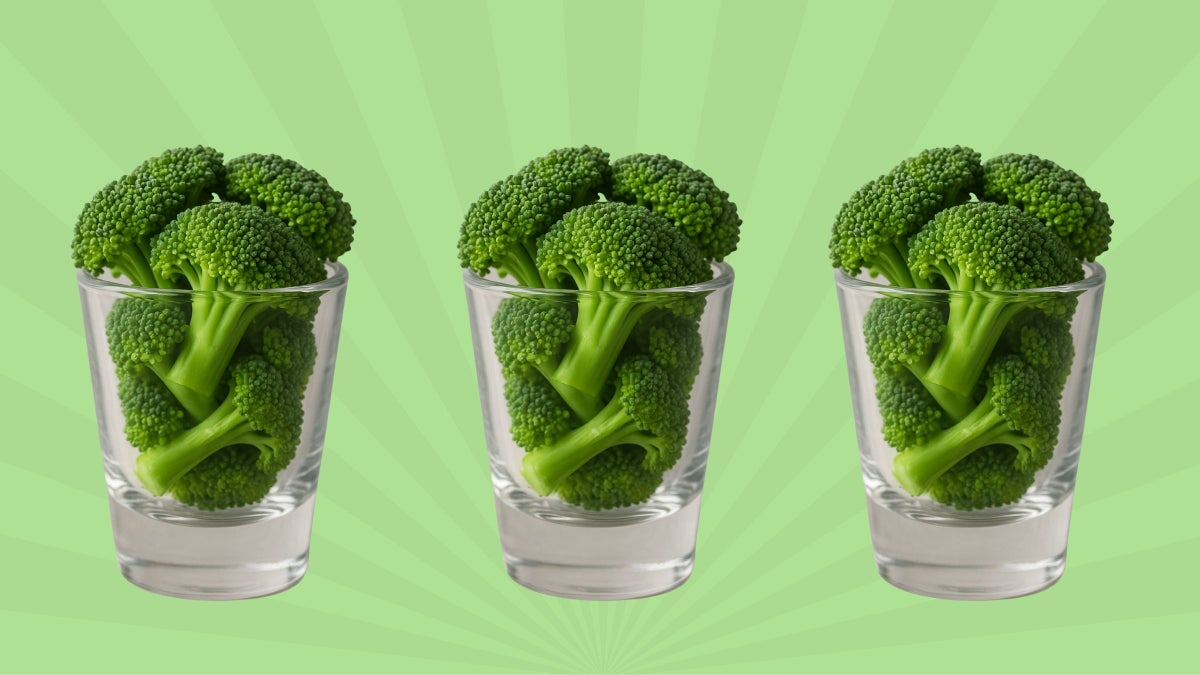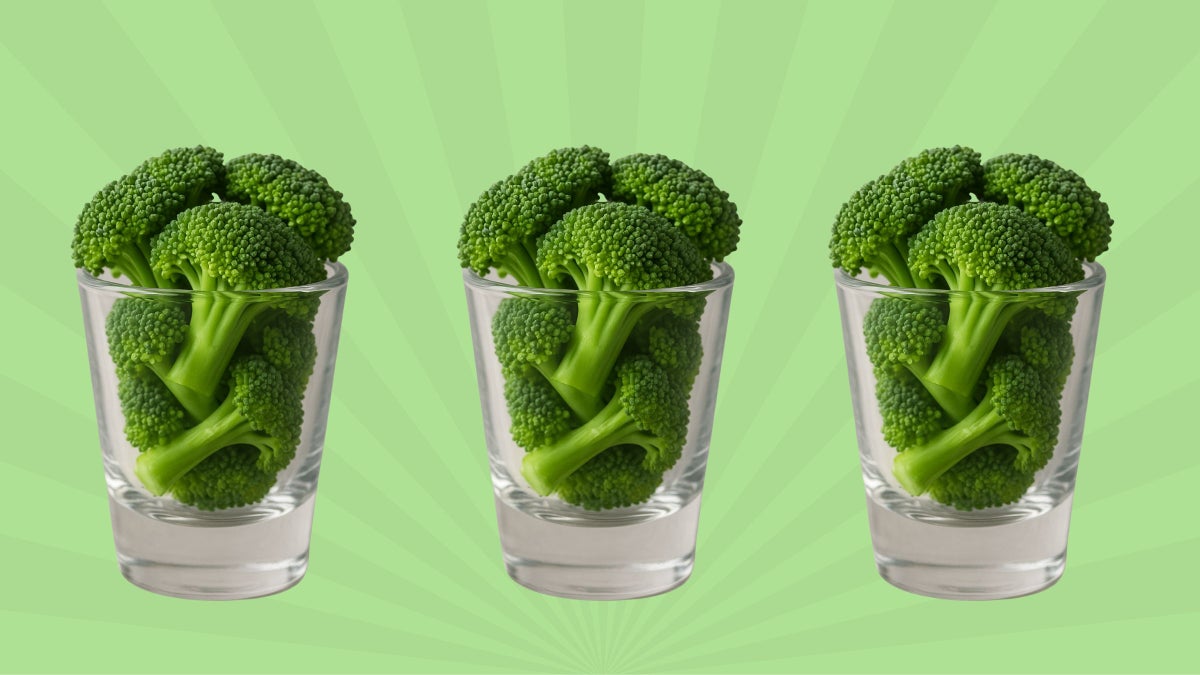
Andreas Almgren, who streaked to a new European half-marathon record of 58:41 earlier this month, swears by it. So does Cole Hocker: “Yeah, I ripped a shot before the 5K,” he said after taking gold in that event at the track and field world championships in Tokyo in September. Mads Pederson, former world cycling champion, credits it with spurring him to his best-ever 90-minute ride.
“It” is a supplement called Nomio, a concentrated shot extracted from broccoli sprouts that has emerged as the hottest new performance-enhancer among elite endurance athletes (as Velo’s Jim Cotton recently reported). The tagline printed on the box and splashed across the company’s website is that it’s “a natural compound that reduces lactate buildup during intense physical activity.” The promise to lower lactate is reminiscent of claims about baking soda, which has swept through endurance sport over the past few years. That’s what is drawing athletes in—but the actual science behind Nomio, preliminary though it remains, suggests a more complicated and perhaps more interesting picture.
Nomio as a Lactate Fighter
The active ingredient in Nomio is isothiocyanates, or ITCs, which are found in cruciferous vegetables such as broccoli, kale, and cabbage. The product was developed by scientists at Sweden’s Karolinska Institute and the Swedish School of Sport and Health Sciences—by some of the same scientists who did pioneering research into the endurance-boosting abilities of the nitrates found in foods such as beets. Beet juice has turned out to be one of the very few purported sports supplements backed by robust evidence, one of just five that the International Olympic Committee gives a thumbs-up to. That parallel is encouraging: maybe another vegetable extract is ready to join the list.
The claims on the Nomio website are all over the map. Not only will it reduce lactate, it will also lower oxidative stress and inflammation, enhance training response to create more mitochondria, and accelerate post-exercise recovery. Oh, and it will also make your legs feel lighter. That sounds suspiciously like a magical pill that makes all your wishes come true—a bargain at $28 for four doses.
The “Science” tab on Nomio’s website offers three references for these claims:
The first is a 2023 study led by Filip Larsen, one of Nomio’s co-founders, in which volunteers took a shot of Nomio (or a placebo) twice a day for a week while completing intense interval workouts on an exercise bike every day. The supplement reduced oxidative stress and lowered lactate levels during exercise, improved regulation of blood glucose, and extended time to exhaustion by about 12 percent in a VO2 max test (though it didn’t actually change VO2 max).
The second study hasn’t yet been published, but is available as a preprint while it undergoes peer review. It’s also from Larsen’s group, led by Michaela Sundqvist. This time it’s a one-shot test: take a broccoli shot, then three hours later do some exercise. Once again, lactate levels were lower at a given speed or power output compared to with a placebo.
The third study is a little more arcane. It involved stimulating individual muscle fibers in a test tube to simulate exercise. In the presence of ITCs, there was a dramatic increase in training response leading to lower oxidative stress and the creation of more mitochondria, the cellular “powerhouses” that are key to aerobic exercise. This was an independent study by David Hood, a prominent muscle physiologist at York University. And it really was independent; when I contacted Hood, he’d never heard of Nomio. But he confirmed the study’s findings: “The results were dramatic for us,” he said. His group is now running a training study in live mice with and without ITCs, with results expected in January.
These studies are certainly suggestive, but two things are missing, from my perspective. One is direct evidence that ITCs enhance performance. Nobody wins a medal for best mitochondria or lowest lactate levels; all we really care about is whether the supplement makes athletes faster. The other is a coherent explanation of why we should expect ITCs to make athletes faster. I’ll come back to the question of evidence below, but let’s start with the why.
Nomio’s Other Origin Story
When I got in touch with Larsen (whose research I’ve written about previously), he explained the evolution of his thinking about ITCs in a way that made more sense to me. It’s not about lactate, or at least it wasn’t initially.
In Larsen’s telling, the starting point was a 2021 study on overtraining. They had volunteers progressively ramp up their training over the course of three weeks, with the final week pushing them into overtraining. At that point, their mitochondria were no longer working as well, their blood sugar control was compromised, and they were slower. “This aligns well with how athletes typically feel when they train harder than they can adapt: muscles feel heavy and unresponsive, and they don’t recover between sessions as they should,” Larsen says. The culprit appeared to be a signaling pathway called Nrf2, which is a key regulator of the body’s antioxidant defenses and (as David Hood and others have shown) how it responds to training.
With those results in mind, Larsen and his team wondered whether boosting Nrf2 might counteract the effects of overtraining. There was already a robust literature showing that ITCs boost Nrf2. “Based on that,” Larsen says, “we simply asked: ‘What happens if we give people ITC (from broccoli sprouts) while they train really hard?’”
That question is what led to the 2023 study mentioned above. As hypothesized, ITCs seemed to protect people from oxidative stress during heavy training. But the other benefits—better blood sugar control, and especially lower lactate during exercise—were surprising. That’s what prompted the second study, where even a single dose of ITCs—as much as you’d get from about six pounds of raw broccoli, packed into a shot glass-sized container—lowered lactate during exercise.
Larsen and his colleagues still aren’t sure why ITCs lower lactate; there are a few possible biochemical explanations, but none has been proven yet. The effects are most apparent when lactate concentrations are in an intermediate range between about 3 and 8 millimolar, which corresponds to moderately hard but not all-out paces of the type you’d see in efforts lasting between about ten minutes and a few hours. (In contrast, the biggest benefits of baking soda are thought to accrue in shorter, more intense efforts between about one and ten minutes.)
Before these lactate findings popped up, though, the original reason for trying ITCs was to fight the oxidative stress caused by hard training. This raises a dilemma, because there’s a well-established body of evidence suggesting that taking high doses of antioxidant supplements can actually blunt the benefits of training. The basic idea is that oxidative stress is a signal that tells your body to adapt and get stronger, so suppressing that signal by taking antioxidants results in less training adaptation.
That’s a genuine concern, Larsen says. But in this case, ITCs aren’t really antioxidants. In fact, they’re mild pro-oxidants, just like exercise itself. In both cases, generating a small amount of oxidative stress causes the body’s own antioxidant defenses, controlled by Nrf2, to kick into higher gear. So instead of eliminating training’s adaptive signal with an antioxidant, Nomio is trying to amplify that signal. Still, Larsen says, that means it’s really only useful if you’re training reasonably hard. “We also recommend that athletes only take it before hard sessions or during tougher training blocks,” Larsen says, “not before easy sessions or on rest days.”
More specifically, the company’s recommended usage plan has two components. For the acute benefits, take one shot three hours before a race or hard workout. For the chronic adaptive benefits, take one shot daily during hard training blocks, three hours before your main workout, then take a second shot before bed on hard workout days, and no shots on rest or easy days. Given the body’s finely tuned antioxidant balance, Larsen says, “I don’t think ITC intake is useful for healthy people who don’t train.”
But Does It Actually Work?
Here’s where things get sticky. In the scientific papers published so far, all we have is that subjects lasted a little longer in a VO2 max test, which isn’t really comparable to a race. Emil Sjölander, one of Nomio’s co-founders, connected me with a few scientists who have done or are doing performance testing either in academia or professional cycling, but none were willing to publicly share the results of their testing.
When I reached out to others who work with professional endurance athletes, the responses were mixed. Everyone had heard of it, and most were at least intrigued. “Their work thus far looks well-done and credible… just not a lot of it yet,” said Trent Stellingwerff, the chief performance officer at the Canadian Sports Institute Pacific, who hasn’t yet worked with any athletes using Nomio. The most skeptical person I spoke to (who asked not to be named) said the data so far seemed “weak and unconvincing,” but they are nonetheless planning a study of Nomio’s effects this fall—which is an expression of interest, if nothing else.
The list of athletes using it, both with and without the company’s cooperation, is long and growing. Among the unpaid names Sjölander mentioned: Conner Mantz, Clayton Young, Sarah Hall, and Graham Blanks. I asked Young about his experiences, and he admitted sharing my initial confusion about what the product’s main goal is. “After reading the research papers, it seemed like much of the science targeted changes in mitochondria,” he wrote in an email. “I was then surprised to see that it was marketed more towards reducing lactic acid levels. Almost as if they wanted to simplify the marketing and label it more as a bi-carb [i.e. baking soda] alternative.”
Still, based on the positive experiences of some of his friends and training partners, Young gave it a shot in the lead-up to the World Championships marathon in Tokyo last month, where he placed ninth despite a hard fall early in the race. “My Tokyo build was one of the best I’ve ever had, if not the best,” he wrote. “My workouts, especially my speed workouts on the track, seem to be better than ever. That being said, there are so many factors that go into training, and it’s hard to say that it all came from Nomio.”
Elite cycling tends to be more data-driven than marathoning, and the most detailed feedback I got on Nomio was from a coach working with a UCI World Tour team, who I agreed not to name. To this coach, the promise of lower lactate was not what interested him. “Biomarkers are one thing, but to know if something really works, it’s hard to get much out of lactate testing,” he said.
Instead, the coach was interested in how the team performed in real-world field trials, which included a mix of moderate and all-out intervals. They didn’t notice an obvious decrease in lactate levels, but most of the riders reported “a feeling that it worked,” and many notched objectively high power outputs compared to their usual training. Proof? Not really. But the team isn’t waiting for further evidence. “If we wait, somebody else will try to use the advantage,” the coach says. “So in our world, you have to be able to work even when you don’t have clear answers.”
It’s hard to say anything more definitive than that for now. The anecdotal evidence is intriguing, but who among us can really say for sure why we’ve had a particularly good or bad day? “The first principle is that you must not fool yourself—and you are the easiest person to fool,” as Richard Feynman once said. That’s why we do studies with placebos and control groups and so on. There’s enough interest in Nomio that those studies will come—or, if they don’t, that their absence will become increasingly glaring. Until then… broccoli season continues.
For more Sweat Science, join me on Threads and Facebook, sign up for the email newsletter, and check out my new book The Explorer’s Gene: Why We Seek Big Challenges, New Flavors, and the Blank Spots on the Map.
The post The Newest Endurance Supplement Is a Broccoli Shot. Does It Work? appeared first on Outside Online.














